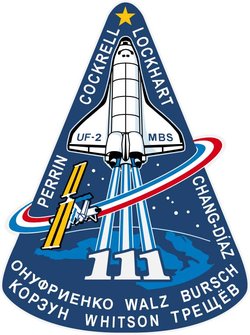STS-111
|
|
This is a mission of the United States Space Shuttle
| Space Shuttle program | |
|---|---|
| Mission Insignia | |

| |
| Mission Statistics | |
| Mission: | STS-111 |
| Shuttle: | Endeavour |
| Launch Pad: | 39-A |
| Launch: | June 5, 2002 5:22:49 p.m. EDT (21:22:49 GMT) |
| Landing: | EAFB June 19, 2002 1:58:45 PM EDT (17:58:45 GMT) Runway 22 |
| Duration: | 13 days, 20 hours, 35 minutes, 56 seconds |
| Orbit Altitude: | 122 nautical miles (226 km) |
| Orbit Inclination: | 51.6 degrees |
| Distance Traveled: | 5.8 million miles (9.3 million km) |
| Crew photo | |
| Missing image Sts-111_crew.jpg | Previous Mission: STS-110 |
Next Mission: STS-112 |
| Contents |
Crew
- Kenneth D. Cockrell (5), Commander
- Paul S. Lockhart (1), Pilot
- Franklin R. Chang-Diaz (7), Mission Specialist
- Philippe Perrin (1) (CNES), Mission Specialist
Launched ISS Expedition 5 Crew:
- Valery G. Korzun (2) (RSA), ISS Commander
- Peggy A. Whitson (1), ISS Flight Engineer
- Sergei Y. Treschev(1) (RSC), Flight Engineer
Landed ISS Expedition 4 Crew:
- Yuri I. Onufrienko (2) (RSA), ISS Commander
- Carl E. Walz (4), ISS Flight Engineer
- Daniel W. Bursch (4), ISS Flight Engineer
Mission Parameters
- Mass:
- Orbiter Liftoff: 116,523 kg
- Orbiter Landing: 99,385 kg
- Payload: 12,058 kg
- Perigee: 349 km
- Apogee: 387 km
- Inclination: 51.6°
- Period: 91.9 min
Docking with ISS
- Docked: June 7, 2002, 16:25:00 UTC
- Undocked: June 15, 2002, 14:32:00 UTC
- Time Docked: 7 days, 22 h, 7 min, 00 s
Space walks
- Chang-Diaz and Perrin - EVA 1
- EVA 1 Start: June 9, 2002 - 15:27 UTC
- EVA 1 End: June 9, - 22:41 UTC
- Duration: 7 hours, 14 minutes
- Chang-Diaz and Perrin - EVA 2
- EVA 2 Start: June 11, 2002 - 15:20 UTC
- EVA 2 End: June 11, - 20:20 UTC
- Duration: 5 hours, 00 minutes
- Chang-Diaz and Perrin - EVA 3
- EVA 3 Start: June 13, 2002 - 15:16 UTC
- EVA 3 End: June 13, - 22:33 UTC
- Duration: 7 hours, 17 minutes
Mission Highlights
The Multipurpose Logistics Module, or MPLM, will carry experiment racks and three stowage and resupply racks to the station. The mission will also install a component of the Canadian Arm called the Mobile Base System (MBS) to the Mobile Transporter (MT) installed during STS-110. This completes the Canadian Mobile Servicing System, or MSS. The mechanical arm will now have the capability to "inchworm" from the U.S. Lab fixture to the MSS and travel along the Truss to work sites.
Related articles
- Space science
- Space shuttle
- List of space shuttle missions
- List of human spaceflights chronologically
- List of ISS spacewalks
- List of spacewalks
External links
- NASA mission summary (http://science.ksc.nasa.gov/shuttle/missions/sts-111/mission-sts-111.html)
| Previous Mission: STS-110 |
Space Shuttle program | Next Mission: STS-112 |
